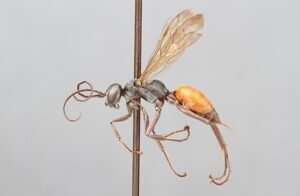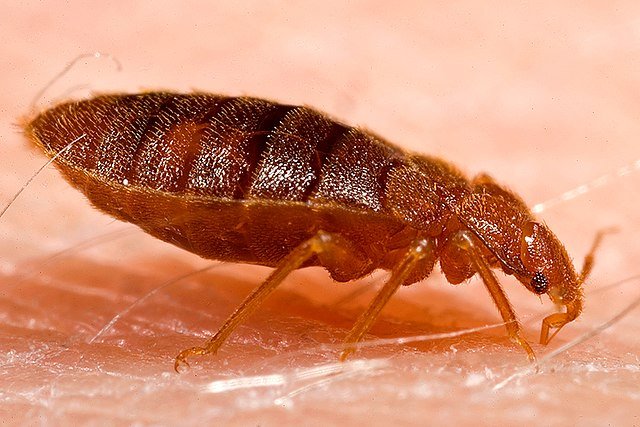Spider Wasps (Pompilidae): Identification, Behavior, and Control
 Few insects command as much respect from pest professionals and entomologists as the spider wasps (family Pompilidae).
Few insects command as much respect from pest professionals and entomologists as the spider wasps (family Pompilidae).
These solitary wasps are nature’s assassins — perfectly evolved to hunt, paralyze, and store spiders as living food for their young.
While they are beneficial predators in most outdoor settings, their presence near homes or workplaces often causes alarm. Their intimidating size, shiny dark color, and strong flight patterns make them easy to mistake for aggressive wasps like paper wasps or hornets, though their behavior is completely different.
I’ve personally encountered dozens of infestations where homeowners panicked after spotting a large black wasp dragging a spider across the patio. The truth is — spider wasps are both fascinating and occasionally problematic. This guide explains how to identify, understand, and manage them safely.
Identification
Spider wasps are easy to recognize once you know their key traits:
Size: Adults range from 10 to 50 mm, depending on the species.
Color: Usually metallic black, blue, or violet, with orange or smoky wings.
Body Shape: Long-legged, slender, with a narrow “waist” typical of wasps.
Behavior: Rapid, erratic walking and wing-flicking while searching for prey.
Sting: Females can sting, but they rarely do unless handled or trapped.
The largest species, Pepsis grossa (tarantula hawk, or tarantula hornet), is infamous for having one of the most painful stings known to science — though it is not aggressive toward humans. Smaller species like Anoplius viaticus or Cryptocheilus comparatus are common in gardens and open fields.
You can often distinguish them from mud daubers or cicada killers by their jerky ground movement — they spend more time running than flying.
Biology and Ecology
Spider wasps belong to the family Pompilidae, which includes over 5,000 species worldwide. All are solitary hunters — they do not form colonies like yellowjackets or paper wasps.
Their life cycle is a masterpiece of biological precision:
Hunting: The female searches for a spider, using sight and vibration.
Attack: She delivers a paralyzing sting, immobilizing the spider instantly.
Transport: She drags the spider — sometimes larger than herself — to a burrow or cavity.
Egg-laying: One egg is laid on the spider’s abdomen.
Feeding: When the larva hatches, it feeds on the still-living but paralyzed spider.
Each larva develops alone, completing its metamorphosis inside the burrow. Adults emerge in late spring or summer, feeding on nectar, honeydew, and occasionally fruit juices.
Although their hunting methods seem brutal, spider wasps play an essential ecological role in keeping spider populations under control, particularly wolf spiders, jumping spiders, and tarantulas.
Global Distribution
Spider wasps occur on every continent except Antarctica.
In North America, species like Pepsis grossa (tarantula hawk) and Anoplius cleora are common in the Southwest and desert regions.
In Europe, Anoplius viaticus and Cryptocheilus comparatus dominate sandy or grassy landscapes.
In Australia, many bright-colored Cryptocheilus species inhabit bushland areas.
In Asia, tropical forests host large metallic-blue pompilids that prey on orb-weaver spiders.
They prefer dry, open soils, where the females can dig burrows, but they can also adapt to urban gardens, walls, sheds, and greenhouses. Their spread has even increased with global trade, as some species travel in plant soil or wooden crates.
Risks and Damage
Spider wasps are not destructive pests in the typical sense — they don’t damage wood, food, or structures.
However, they can pose several minor risks or inconveniences:
Stings: Painful but rare. The sting is defensive, not aggressive.
Nesting Indoors: Occasionally, they enter houses or garages searching for spiders or dry soil to nest.
Public Panic: Their large size and behavior can frighten people, leading to unnecessary extermination.
Workplace Concerns: In commercial kitchens, warehouses, or schools, their presence can cause health and safety worries even though they’re not dangerous.
From a pest management perspective, spider wasps become relevant only when they nest repeatedly indoors or in high-traffic outdoor zones.
Signs of Infestation
Spider wasps don’t build colonies, so “infestation” is usually limited to one or a few individuals. However, signs may include:
Wasps entering and exiting cracks in walls or ground holes.
Paralyzed spiders lying near doorsteps, patios, or garages.
Continuous sightings of wasps dragging spiders.
Burrows or small holes appearing in bare soil or under concrete slabs.
If you observe several adults in one area, it could indicate multiple nests in soft soil nearby.
Control Methods
1. Inspection
First, confirm that you are dealing with spider wasps, not paper wasps or hornets. Watch their movement — spider wasps walk on the ground more often than flying around nests.
2. Habitat Modification
Remove excess spider populations, since they attract female wasps looking for hosts.
Keep outdoor lights limited at night (they attract spiders and, in turn, the wasps).
Fill in cracks, soil holes, and old rodent burrows where they might nest.
3. Physical Removal
If you spot a single nest or burrow, you can flood it with water or cover it with soil to discourage reuse.
Indoors, use a vacuum to remove wandering wasps safely. Release them outside if possible — they’re beneficial outdoors.
4. Chemical Control (Professional Use)
In rare cases where nests are near sensitive areas (schools, food facilities, playgrounds), professionals may apply residual insecticides on entry points or soil surfaces.
Typical active ingredients include pyrethroids, used according to label instructions and never sprayed on flowering plants or where bees feed.
Because spider wasps are solitary and sensitive to pesticides, broad chemical control is neither necessary nor ethical.
5. Preventive Measures
Maintain clean, dry surroundings.
Reduce clutter, especially around windows or basements.
Keep window screens intact to prevent accidental entry.
Advanced Approaches
In some conservation areas and eco-sensitive facilities, pest managers use biological and mechanical methods rather than chemicals.
For instance:
Spider population management using traps or exclusion nets.
Barrier dusts (like silica aerogel) applied to entry points.
Low-toxicity insecticidal foams for voids.
In greenhouses, professionals sometimes use UV light monitoring to detect unwanted wasp presence early, especially where pollinator protection is a priority.
Cultural and Historical Context
Spider wasps have fascinated humans for thousands of years. Ancient Greeks described them as “the mothers of spider death,” and indigenous Australian myths considered them guardians of the soil.
In ancient Egypt, wasps were symbols of determination and courage — qualities still fitting for these hunters.
Modern biologists admire them for their precise hunting behavior and neurological control of prey, often used as a model in behavioral research.
Interestingly, in the southwestern United States, the tarantula hawk (Pepsis grossa) was once the state insect of New Mexico, symbolizing both beauty and resilience.
FAQ
1. Are spider wasps dangerous to humans?
Not really. They sting only when handled or trapped. Their venom is strong but rarely causes medical complications.
2. Why are spider wasps in my house?
They may be chasing spiders indoors or seeking dry soil for nesting in wall cracks or basements.
3. Do they kill useful spiders too?
Yes — they’re indiscriminate hunters, but overall they help regulate spider populations naturally.
4. Can I remove spider wasps without chemicals?
Yes. Seal openings, reduce spiders, and use a vacuum to capture stray wasps safely.
5. What do spider wasps eat?
Adults feed on nectar, honeydew, and plant juices; larvae feed exclusively on paralyzed spiders.
6. Do they form hives or colonies?
No. Each female works alone — there is no queen, no workers, and no shared nest.
7. What’s the difference between spider wasps and mud daubers?
Mud daubers build visible mud nests on walls and feed on spiders too, but spider wasps dig into soil and don’t reuse nests.
Final Thoughts
The spider wasp (family Pompilidae) is one of nature’s most skilled hunters — precise, powerful, and efficient.
In my years of pest control work, I’ve often told clients that this insect is both a threat and an ally. Outdoors, it helps keep spider populations under control, preventing infestations of wolf spiders, huntsman spiders, and orb weavers. But indoors or in sensitive public areas, its presence can create unnecessary panic.
If you see a few spider wasps flying around your garden, let them work — they’re on your side.
But if you notice them nesting close to entrances, schools, or businesses, it’s better to call a licensed pest control expert. A trained professional will know where to apply insecticides safely and how to minimize risks to pollinators and beneficial insects.
As with all solitary wasps, prevention is simple: seal cracks, control spider food sources, and maintain dry, well-ventilated spaces. When we understand their role in the ecosystem, managing them becomes not just easier — but smarter.
Disclaimer
This article is for informational purposes only. Pest control laws and approved chemicals vary by country. For best results and legal safety, we strongly recommend contacting a licensed pest control professional in your local area. Always make sure that the pest control technician is properly certified or licensed, depending on your country’s regulations. It’s important to confirm that they only use approved products and apply them exactly as instructed on the product label. In most places in Europe, UK, or USA, following label directions is not just best practice—it’s the law.
Author
Nasos Iliopoulos
BSc Agronomist & Certified Pest Control Expert
Scientific Director – Advance Services (Athens, Greece)
Licensed Pest Control Business – Ministry of Rural Development & Food (GR)
References
NC University - Spider Wasp
Wikipedia - Spider Wasp

